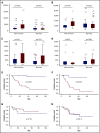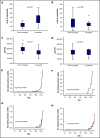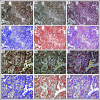Dynamic angiopoietin-2 assessment predicts survival and chronic course in hospitalized patients with COVID-19
- PMID: 33560382
- PMCID: PMC7876870
- DOI: 10.1182/bloodadvances.2020003736
Dynamic angiopoietin-2 assessment predicts survival and chronic course in hospitalized patients with COVID-19
Abstract
This study examined the association between dynamic angiopoietin-2 assessment and COVID-19 short- and long-term clinical course. We included consecutive hospitalized patients from 1 February to 31 May 2020 with laboratory-confirmed COVID-19 from 2 Italian tertiary referral centers (derivation cohort, n = 187 patients; validation cohort, n = 62 patients). Serum biomarker levels were measured by sandwich enzyme-linked immunosorbent assay. Lung tissue from 9 patients was stained for angiopoietin-2, Tie2, CD68, and CD34. Cox model was used to identify risk factors for mortality and nonresolving pulmonary condition. Area under the receiver operating characteristic curve (AUROC) was used to assess the accuracy of 3- and 10-day angiopoietin-2 for in-hospital mortality and nonresolving pulmonary condition, respectively. Three-day angiopoietin-2 increase of at least twofold from baseline was significantly associated with in-hospital mortality by multivariate analysis (hazard ratio [HR], 6.69; 95% confidence interval [CI], 1.85-24.19; P = .004) with AUROC = 0.845 (95% CI, 0.725-0.940). Ten-day angiopoietin-2 of at least twofold from baseline was instead significantly associated with nonresolving pulmonary condition by multivariate analysis (HR, 5.33; 95% CI, 1.34-11.77; P ≤ .0001) with AUROC = 0.969 (95% CI, 0.919-1.000). Patients with persistent elevation of 10-day angiopoietin-2 levels showed severe reticular interstitial thickening and fibrous changes on follow-up computed tomography scans. Angiopoietin-2 and Tie2 were diffusely colocalized in small-vessel endothelia and alveolar new vessels and macrophages. Angiopoietin-2 course is strongly associated with COVID-19 in-hospital mortality and nonresolving pulmonary condition. Angiopoietin-2 may be an early and useful predictor of COVID-19 clinical course, and it could be a relevant part of disease pathogenesis. Angiopoietin-2 blockade may be a COVID-19 treatment option.
© 2021 by The American Society of Hematology.
Conflict of interest statement
Conflict-of-interest disclosure: E.V. has consulted for and received honoraria from Abbvie, MSD, and Gilead. F.S. has received travel reimbursements from Cook. C. Cammà consulted for and received honoraria from Abbvie, MSD, and Gilead. The remaining authors declare no competing financial interests.
Figures





References
-
- Kim I, Kim HG, So JN, Kim JH, Kwak HJ, Koh GY. Angiopoietin-1 regulates endothelial cell survival through the phosphatidylinositol 3′-Kinase/Akt signal transduction pathway. Circ Res. 2000;86(1):24-29. - PubMed
-
- Papapetropoulos A, Fulton D, Mahboubi K, et al. . Angiopoietin-1 inhibits endothelial cell apoptosis via the Akt/survivin pathway. J Biol Chem. 2000;275(13):9102-9105. - PubMed
-
- Fiedler U, Augustin HG. Angiopoietins: a link between angiogenesis and inflammation. Trends Immunol. 2006;27(12):552-558. - PubMed
Publication types
MeSH terms
Substances
LinkOut - more resources
Full Text Sources
Other Literature Sources
Medical
Miscellaneous

